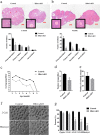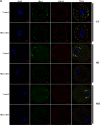Hfm1 participates in Golgi-associated spindle assembly and division in mouse oocyte meiosis
- PMID: 32606310
- PMCID: PMC7327073
- DOI: 10.1038/s41419-020-2697-4
Hfm1 participates in Golgi-associated spindle assembly and division in mouse oocyte meiosis
Abstract
HFM1 (helicase for meiosis 1) is widely recognized as an ATP-dependent DNA helicase and is expressed mainly in germ-line cells. HFM1 is a candidate gene of premature ovarian failure (POF), hence it is also known as POF9. However, the roles of HFM1 in mammalian oocytes remain uncertain. To investigate the functions of HFM1, we established a conditional knockout (cKO) mouse model. Specific knockout of Hfm1 in mouse oocytes from the primordial follicle stage resulted in depletion of ovarian follicular reserve and subfertility of mice. In particular, abnormal spindle, misaligned chromosomes, loss of cortical actin cap, and failing polar body extrusion were readily observed in Hfm1-cKO oocytes. Further studies indicated that in addition to its cytoplasmic distribution, Hfm1 accumulated at the spindle poles, colocalized with the Golgi marker protein, GM130. Generally, GM130 signals overlapped with p-Mapk at the two spindle poles to regulate meiotic spindle assembly and asymmetric division. In this research, centrosome associated proteins, such as GM130 and p-Mapk, detached from the spindle poles in Hfm1-cKO oocytes. In conclusion, our data suggest that Hfm1 participates in Golgi-associated spindle assembly and division in mouse oocyte meiosis. These findings provide clues for pathogenesis of POF.
Conflict of interest statement
The authors declare that they have no competing interests.
Figures





Similar articles
-
RhoA-mediated FMNL1 regulates GM130 for actin assembly and phosphorylates MAPK for spindle formation in mouse oocyte meiosis.Cell Cycle. 2015;14(17):2835-43. doi: 10.1080/15384101.2015.1031438. Epub 2015 Jun 17. Cell Cycle. 2015. PMID: 26083584 Free PMC article.
-
GM130, a cis-Golgi protein, regulates meiotic spindle assembly and asymmetric division in mouse oocyte.Cell Cycle. 2011 Jun 1;10(11):1861-70. doi: 10.4161/cc.10.11.15797. Epub 2011 Jun 1. Cell Cycle. 2011. PMID: 21552007
-
RAB8A GTPase regulates spindle migration and Golgi apparatus distribution via ROCK-mediated actin assembly in mouse oocyte meiosis†.Biol Reprod. 2019 Mar 1;100(3):711-720. doi: 10.1093/biolre/ioy217. Biol Reprod. 2019. PMID: 30285101
-
Nuclear and spindle positioning during oocyte meiosis.Curr Opin Cell Biol. 2011 Feb;23(1):78-84. doi: 10.1016/j.ceb.2010.07.008. Epub 2010 Aug 11. Curr Opin Cell Biol. 2011. PMID: 20708397 Free PMC article. Review.
-
The chromosomal basis of meiotic acentrosomal spindle assembly and function in oocytes.Chromosoma. 2017 Jun;126(3):351-364. doi: 10.1007/s00412-016-0618-1. Epub 2016 Nov 11. Chromosoma. 2017. PMID: 27837282 Free PMC article. Review.
Cited by
-
HFM1 is essential for the germ cell intercellular bridge transport in primordial follicle formation in mice.Cell Mol Life Sci. 2024 Dec 27;82(1):28. doi: 10.1007/s00018-024-05541-4. Cell Mol Life Sci. 2024. PMID: 39725823 Free PMC article.
-
Human amnion-derived mesenchymal stem cells improved the reproductive function of age-related diminished ovarian reserve in mice through Ampk/FoxO3a signaling pathway.Stem Cell Res Ther. 2021 Jun 2;12(1):317. doi: 10.1186/s13287-021-02382-x. Stem Cell Res Ther. 2021. PMID: 34078462 Free PMC article.
-
Downregulation of LHCGR Attenuates COX-2 Expression and Induces Luteinized Unruptured Follicle Syndrome in Endometriosis.Front Endocrinol (Lausanne). 2022 May 4;13:853563. doi: 10.3389/fendo.2022.853563. eCollection 2022. Front Endocrinol (Lausanne). 2022. PMID: 35600595 Free PMC article.
-
Maternal loss-of-function of Nlrp2 results in failure of epigenetic reprogramming in mouse oocytes.Res Sq [Preprint]. 2024 Jun 4:rs.3.rs-4457414. doi: 10.21203/rs.3.rs-4457414/v1. Res Sq. 2024. PMID: 38883732 Free PMC article. Preprint.
-
Advances in the genetic etiology of female infertility.J Assist Reprod Genet. 2024 Dec;41(12):3261-3286. doi: 10.1007/s10815-024-03248-w. Epub 2024 Sep 25. J Assist Reprod Genet. 2024. PMID: 39320554 Review.
References
Publication types
MeSH terms
Substances
LinkOut - more resources
Full Text Sources
Molecular Biology Databases
Miscellaneous

